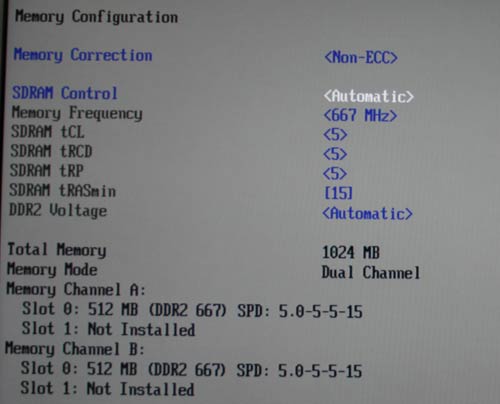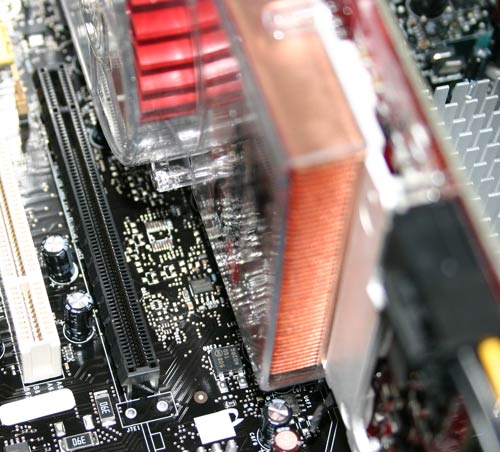Intel Dual Core Performance Preview Part I: First Encounter
by Anand Lal Shimpi on April 4, 2005 2:44 PM EST- Posted in
- CPUs
The Platform: Intel 955X
AMD's dual core Athlon 64 processors will work in all current Socket-939 motherboards with merely a BIOS update. The same level of compatibility obviously isn't true for Intel's dual core solutions. You'll need a new motherboard to support the Pentium D and Pentium Extreme Edition chips, and thus, Intel shipped us a board based on their soon-to-be released 955X platform.

The platform boasts a dual channel DDR2-667 memory controller, but given that the chips still only support an 800MHz FSB, the added bandwidth of DDR2-667 is useless. Even for bragging rights, running at DDR2-667 doesn't make sense, as the memory that Intel shipped with the system is rated at 5-5-5-15 timings at 667MHz. Wasted bandwidth and higher latency memory is nothing to get excited about in our book. We're not entirely sure what Intel is up to, but they had better plan on increasing the FSB of their chips really soon if they want DDR2-667 (or even 533) to gain any sort of acceptance.

Other than support for dual core, faster DDR2, RAID 5 and 8GB of ECC memory, the 955X doesn't have any features to boast over the current platforms. It does look like Intel may be planning SLI support for the 955X however:

The 955X board that we received had two physical x16 PCIe connectors, but only one of them was electrically a x16 slot.
Despite Intel's warnings not to make any judgments about final performance or stability, both the 955X and the Pentium Extreme Edition were as rock solid during our testing as any product that we've encountered. This was quite possibly the most stable encounter with a pre-release CPU, chipset and drivers that we've ever had. That being said, we really didn't expect Intel to break tradition with a platform of which they weren't 100% sure.










141 Comments
View All Comments
hosto - Tuesday, April 5, 2005 - link
#110 - did you notice better performance on the p4 that you used to have? because on single instance of firefox, the amd chips blow the p4's away....yet, when i have multiple panes open with my a64 it chugs quite nastily if there is flash content. Is there some way that macromedia have optimised the flash player for the P4 for firefox? i wonder if the same slowdowns would be noticeable with internet explorer, or if it is specific to the player in firefox/mozilla?xsilver - Tuesday, April 5, 2005 - link
#106I hope you mean in multithreaded apps, as has been said many times before... single threaded apps run the SAME, therefore no benchies were included
#108
So true --- its the only reason why I wish I still had my p4HT over the amd64
xsilver - Tuesday, April 5, 2005 - link
ANAND ... for your gaming benchmarks I recommend a scattering of commonly used programs1) the lot of antivirus, trillian, firefox, spyware running in background
2) gaming related stuff like teamspeak or an audio cd playing in the background (to drown out the crappy game music :)
any other gaming related stuff would be good too....
if dual core proves itself, there should be no performance drop, whereas the single core will drop somewhat
hosto - Tuesday, April 5, 2005 - link
thats funny the comment about the flash going slowly in firefox on the AMD processors in the benchmark..ive noticed the same on my athlon64 3200+ that i cannot have too many flash sites opening without it chugging.sprockkets - Tuesday, April 5, 2005 - link
this would be funny, but if simply having another core helps out with responsiveness and nothing else, I'm getting the dual VIA C3 mini-itx board hahahahaha!OK, not dual core, but hell, it's still small enough and they take only 7w each.
ksteele - Tuesday, April 5, 2005 - link
I would like to see some "apple to apple" benchmarks by removing the clock speed disparities.Pentium D 820 2.8Ghz versus Pentium 4 520 2.8Ghz
Pentium D 830 3.0Ghz versus Pentium 4 530 3.0Ghx
Pentium D 840 3.2Ghz versus Pentium 4 540 3.2Ghz
This will allow us to see the true benefit of dual cores without the speed differences.
mino - Tuesday, April 5, 2005 - link
sorry for some typpo'smino - Tuesday, April 5, 2005 - link
#101 and some othersYou'are mistaken, Inquirer is NOT to be compared to AT. Is is solely news/romours/opinions site and THAT IS THEY ARE BEST AT ! The practical(not theoretical as at CNN...)non-existence of censorship makes them what they are.
One thing for sure: they make biased and wrong stance against AT on this, but this is what they do almost all the time.
The beauty of The Inquirer's approach to journalism is that it let's the reader choose which report is to be taken seriously. They even state it in articles regularly.
I just hate those juornalists that usurp the right for correct judgement just for themselves.
Just to make clear: I'm in no relation to The Inq. except readeship.
To Anand:
This is one of the best articles(at all) a have read so far. And it looks like it's going to be even better when it's completed. Keep up the good work.
To topic: One thing should be noted. That is that the VERY poor performance at the singlecore(AMD & intel HT off) scenarios is NOT to be atributed to their inferiority but mostly to the incredibly crappy windows scheduler. Availability of multiple CPU's to it just partly hides its inefficiencies. Let's face it. HT is mainly a Windows baby. No way Intel would make the trouble developing it *NIX system were the main ones.
ksteele - Tuesday, April 5, 2005 - link
I noticed the dual core's have 1MB L2 cache. Does this mean they are 5xx based? Do they support Intel EM64T, XD Bit and Enhanced Intel Speedstep Technology?Gatak - Tuesday, April 5, 2005 - link
#83 So you do not think that a game can utilize two CPUs? Run physics and I/O on one Core and render 3D and textures on the other.Also, Even though a game is single threaded, you still have the OS in the background, you have the video and audio card drivers running in separate threads. harddisk I/O and interrupt handling is also spread out on multiple cores.